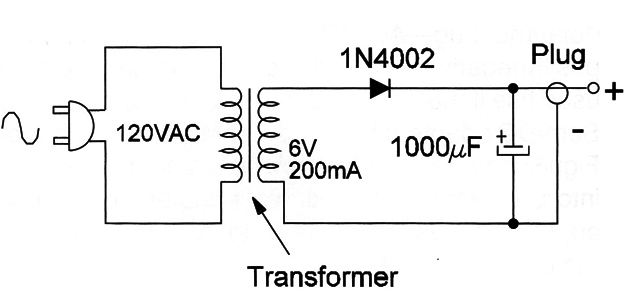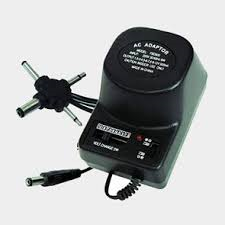AC/DC adapters are formed by a simple circuit with a transformer to isolate the AC power line, avoiding shock hazards and stepping down the voltage to the desired value. Current follows the transformer leads to a rectifier (diode) and a filter (capacitor) in a typical configuration like the one shown in Figure 1.

The output to the powered device is normally made by a cable with a plug as shown in the same figure. There are some details an technician should pay attention to when using an AC/DC converter.
Output voltage-output voltage can vary from 1.5V (one cell) to 15V (ten cells or a battery) for common AC/DC adapters. In some types, this voltage is fixed; you choose the voltage when buying the unit based on the voltage of the appliance. It is easy to identify this voltage from the number of cells. Each cell represents 1.5V, so if the powered device uses four cells it needs an AC/DC converter for 6V (4 x 1.5V). Some converters have a switch to choose the voltage. This switch can be adjusted based on the voltage of the powered device. It is important to make the correct adjustment because if it is a higher voltage than supported by the device, that device can be damaged.
Output current-nominal output current is determined by the consumption of the appliance you intend to power. Normally, the consumption is evaluated by the size and type of the cells or batteries used to power it. ln many of the cases, the current is indicated in the device, but if this is information is not available, use the next table to choose an AC/DC adapter.
| Type of Cell | Current |
| AA | 100 to 200 mA |
| C | 300 to 500 mA |
| D | 1 to 1.5 A |
| 9V cells | 50 to 200 mA |
Polarity of the pIug-AC/DC adapters can be supplied by plugs with a positive or negative pole in the center. Be sure that the correct plug is used because if the polarity is inverted, the appliance can be damaged.
Some AC/DC adapters have a switch to choose the polarity of the plug.
Figure 2 shows a universal power adapter that can be plugged directly into the AC power line. This kind of adapter can be used to power small appliances, such as CD players, toys, video games, calculators, and radios.

An important point to observe is that common AC/DC adapters, in general, are very simple circuits with no voltage regulation stages. This means that the circuit presents a higher voltage in the output until the moment the appliance is plugged in, then it drops.
This tact is important when testing an AC/DC adapter; the measured voltage in the output is normally higher than the adjusted or expected load until the device is powered on. When powering appliances where voltage is critical from the AC power line, it is important to use the specified types of adapters recommended by the manufacturer.